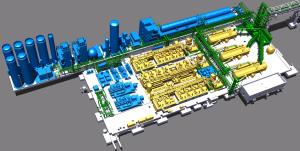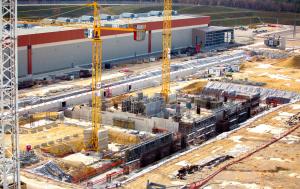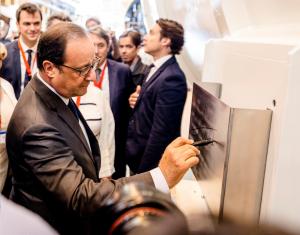As a consequence, the ITER cryoplant—three coupled units that will provide cooling fluids to the whole installation—will be the largest in the world, with 75 MW of combined cooling power
(1).
Liquid helium will be delivered to ITER in 40-cubic-metre containers. (In a prowess of insulation technology, the -269 °C temperatures will be maintained throughout the 45-day-long journey from the production site to the ITER cryoplant. About seven container loads will be needed to fill the entire helium cooling circuit of the ITER installation.
The complexity of the cooling processes, along with the flux rate required for the cooling of magnets, cryopumps and thermal shield, has dictated the size and design of the cryoplant.
The soccer field-size installation will comprise three identical liquid helium plants—the best solution in terms of technology, economy and risk. Each plant will rely on six powerful megawatt-class screw-compressors, four high-speed turbines and ten aluminium-brazed heat exchangers assembled in 20-metre-long vacuum-insulated "cold boxes."
At the Air Liquide workshop outside of Grenoble, France, workers are in the process of equipping the cold boxes with their internal components. (During a visit to the factory last summer, French President François Hollande
autographed one of them.)
Operating the cryoplant will require 35 MW of electrical power—comparable to the needs of a European town with a population of approximately 45,000. The cryoplant will operate non-stop but will only deliver its maximum cooling power during plasma discharges.
Helium is not the only ultra-cold fluid that the cryoplant will produce. Liquid nitrogen, at a temperature of minus 196 °C, will be used as a "pre-cooler" in the liquid helium plants.
Nitrogen, which accounts for approximately 78 percent of the air we breathe, will be extracted directly from the atmosphere in an on-site gaseous nitrogen generator with a production capacity of 50 tons per day and then processed in two large liquid nitrogen plants.
Magnets are the main consumers of cryogenic power (45 percent), followed by the thermal shield (40 percent) and the cryopumps (15 percent). But of the total cryogenic power delivered by the cryoplant, only 75 percent will actually cool the machine components—the remaining 25 percent of the nominal 75 kW will be needed to compensate the warming of the fluid due to the rotating pumps and, to a much lesser extent, the thermal losses in the five-kilometre long cryodistribution network.




